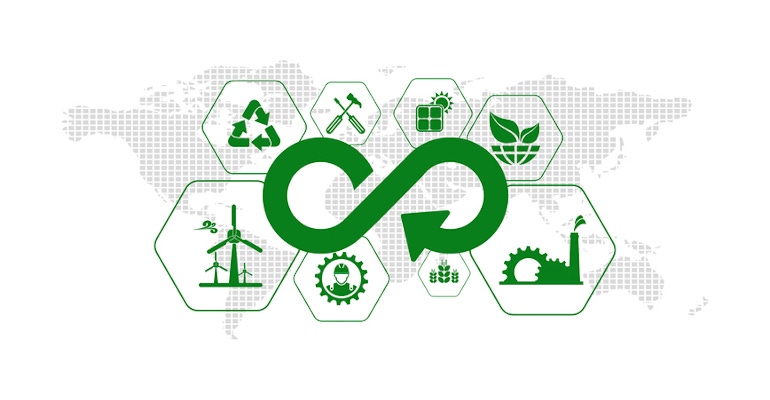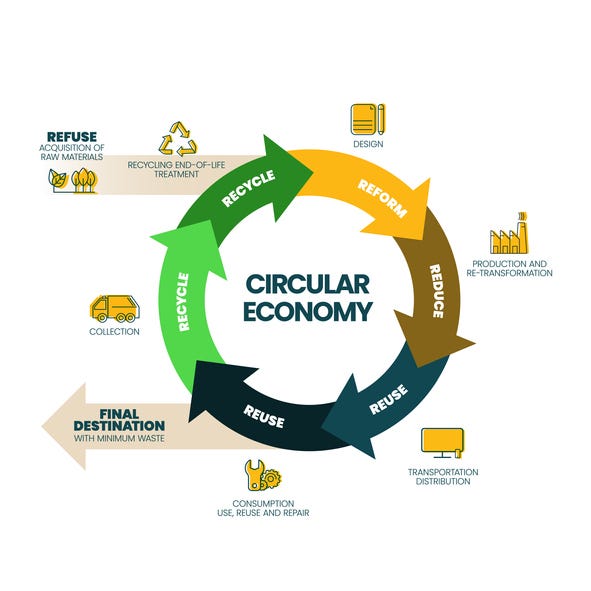AI Could Help You Engineer a Circular Economy
Mechanical engineers can utilize AI to create a better circular economy for sustainability.
July 26, 2023

Driven by government regulations, consumer demand, and the necessity of meeting climate and sustainability targets, societies and businesses have begun the transition toward a circular economy. In a circular economy, materials are continuously cycled back into reuse through recycling, refurbishment, and remanufacturing, creating a closed-loop system and minimizing waste. This is in contrast to the linear economy, in which resources are extracted, processed into products, used, and then discarded.
The benefits of a circular economy are numerous. Keeping materials in circulation reduces strain on resource supplies and ecosystems and minimizes waste generation and landfilling. On the consumer end, a circular economy provides customers with more durable, long-lasting products. Perhaps most importantly, a circular economy aids in climate change mitigation by reducing the carbon emissions associated with resource extraction, manufacturing, and waste disposal.
Engineers can contribute to the adoption of a circular economic model through the development and implementation of sustainable technologies and systems that contribute to resource conservation. Additionally, artificial intelligence (AI) technologies like generative design, natural language processing, and digital twin technology can assist in the development of a circular economy. By harnessing these technologies, engineers can help expedite the arrival of a circular economy.
Engineering a Circular Economy
Reducing waste and resource use in the product lifecycle begins during the design phase. This includes designing products with a focus on durability, reparability, and recyclability. Modular design, in which products are made up of parts that can be removed and exchanged without affecting the other parts, is also an important component of circular design. By considering the entire lifecycle of a product during the design stage, engineers can incorporate materials and components that are easier to disassemble, reuse, or recycle. They also can explore alternative materials that are renewable and non-toxic and have lower environmental impacts.
Engineers can help optimize these processes to minimize waste generation, energy consumption, and resource use, using digital technologies to monitor and reduce resource use where applicable. They also can develop efficient recycling technologies, waste management systems, and processes for remanufacturing and refurbishing products.
To enable the switch to an efficient circular economy, it is vital for engineers to apply systems thinking and interdisciplinary approaches and use their soft skills to foster collaboration among various stakeholders. For the best results, it is important to leverage emerging technologies to their fullest extent.
AI’s Contributions to a Circular Economy
AI is one example of a rapidly developing technology that, if deployed correctly, can help speed the transition to a circular economy. AI’s contributions to the circular economy include:
Data collection and analysis. AI can gather and analyze data related to recycling rates, resource consumption, waste generation and management, supply chain operations, consumer behavior, product design, and lifecycle assessment. Tools for analyzing data with machine learning and AI include TensorFlow, scikit-learn, and PyTorch.
Predictive analytics. AI and machine learning (ML) tools can help organizations minimize waste by predicting demand accurately, aiding in reaching sustainability and circularity targets. These technologies can identify patterns, forecast demand, optimize inventory levels, and predict potential bottlenecks. Tools available for integrating AI with predictive analytics include RapidMiner, DataRobot’s AI platform, and the Microsoft Azure Machine Learning Studio.
Supply-chain optimization. AI can optimize operations and minimize environmental impact by considering factors including transportation routes, production schedules, and waste reduction. Examples of tools that utilize AI for supply-chain operations include IBM CPLEX, Gurobi, and the MATLAB Optimization Toolbox.
Predictive maintenance. By identifying potential failures, recommending maintenance actions, and enabling proactive repairs, AI can extend the lifecycle of many products. China-based technology company Huawei, for example, has created AI-based predictive maintenance tools for elevators.
Natural language processing (NLP). NLP tools, including NLKT, spaCy, and Gensim, can analyze textual data and extract relevant information for decision-making. Organizations can leverage NLP to identify emerging trends and assess public sentiment toward sustainability.
Material selection. With AI tools, engineers can analyze large databases of material properties, environmental data, and regulatory information to recommend which materials to use based on factors such as availability, recyclability, toxicity, and carbon footprint. Tools that use AI for materials selection include Granta MI, CES Selector, and Sustainable Minds.
Waste sorting and recycling. AI-powered robotic systems identify and sort different waste materials, enabling more-effective recycling, reducing contamination, and increasing resource recovery rates. Startups, including AMP Robotics and CleanRobotics, are implementing automated recycling systems using robotics and ML.
Economic analytics. By combining and analyzing data from various sources, including material flows, environmental impact assessments, and economic indicators, AI analytics help identify opportunities for circular interventions, measure progress, and inform strategic decision-making toward a more sustainable circular economy.
Consumer engagement. AI-powered chatbots or virtual assistants can provide consumers with information on sustainable product choices, recycling options, and circular initiatives, encouraging sustainable consumption behaviors.
Generative design. AI algorithms can generate multiple design iterations for a product, which can then be evaluated based on material efficiency, weight reduction, and end-of-life considerations. Generative Design in Autodesk and nTopology are tools that use AI for generative design.
Digital twin technology. A digital twin is a virtual replica of a physical product or system used to gather data and optimize product performance, maintenance strategies, and end-of-life scenarios. Examples of digital twin tools include Perforce Helix Core, Autodesk Digital Twin, and Predix from GE Digital.

Important Considerations in Using AI to Build the Circular Economy
The role of engineers in building the circular economy extends beyond developing durable and sustainable products and processes. A successful transition to the circular economy requires a mindset change among consumers and stakeholders. Engineers can support shifting consumer behavior by developing technologies and systems that facilitate consumer engagement in the circular economy, such as smart devices, information systems, and user-friendly interfaces.
Equally important are policy and regulatory frameworks that incentivize circular practices. Engineers can contribute to policy changes by providing data-driven insights to policymakers. The transition to a circular economy requires collaboration and knowledge sharing among many different stakeholders and types of experts, and mechanical engineers have an important role to play in facilitating this collaboration.
It is also essential to consider the ethical implications of AI technologies. Collecting and analyzing large amounts of data may raise privacy and security concerns. Additionally, there could be ethical considerations related to AI decision-making processes, accountability, and transparency, as some AI algorithms have demonstrated bias among other issues. Engineers can ensure that addressing these concerns is a priority, which will facilitate the responsible and ethical use of AI in the circular economy.
As businesses recognize the economic, environmental, and social benefits circular economic practices provide, their adoption will continue to grow. Additional drivers are shifting consumer preferences and government initiatives, including more stringent waste regulations and tax incentives for circular practices. Advances in technology, including AI, robotics, and digitization, will play a crucial role in enabling the coming economic transformation. AI can assist in circular product design, predictive maintenance, supply chain management, waste disposal, and more, though it is important to ensure that these technologies are being used ethically and responsibly. By leveraging AI’s capabilities, mechanical engineers can drive innovation, optimize resource utilization, and contribute to a more sustainable future.
About the Author(s)
You May Also Like



